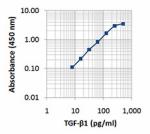- Clone
- 21C11 (See other available formats)
- Regulatory Status
- RUO
- Other Names
- Transforming growth factor-beta 1 (TGF-b1), TGFB1, CED, DPD1
- Isotype
- Mouse IgG2a, κ

| Cat # | Size | Price | Quantity Check Availability | ||
|---|---|---|---|---|---|
| 525301 | 50 µg | $101.00 | |||
Transforming growth factor beta 1 (TGF-β1) is a member of the transforming growth factor beta superfamily of cytokines. The TGF-β1 precursor contains 390 amino acids with an N-terminal signal peptide of 29 amino acids required for secretion from a cell, a 249 amino acid pro-region (latency associated peptide or LAP), and a 112 amino acid C-terminal region that becomes the active TGF-β1 upon activation.
Both LAP and TGF-β1 exist as homodimers in circulation, but the disulfide linked homodimers of LAP and TGF-β1 remain non-covalently associated, forming the small latent TGF-β complex (SLC, 100 kD). The large latent TGF-β complex (LLC, 235-260 kD) contains a third component, the latent TGF-β binding protein (LTBP), which is linked to LAP by a single disulfide bond. LTBP does not confer latency but is for efficient secretion of the complex to extracellular sites. Free active TGF-β1 can be released (activated) by many factors, including enzymes and low or high pH.
TGF-β1 is nearly 100% conserved across mammalian species. It has diverse biological functions in multiple cellular processes such as regulating proliferation and differentiation of various cell types. TGF-β1 is also an important immunoregulatory cytokine, which is involved in the maintenance of self-tolerance, Th17 differentiation, and T-cell homeostasis.
Product Details
- Verified Reactivity
- Human, Mouse, Rat
- Reported Reactivity
- Other species
- Antibody Type
- Monoclonal
- Host Species
- Mouse
- Immunogen
- Human TGF-β1
- Formulation
- Phosphate-buffered solution, pH 7.2, containing 0.09% sodium azide.
- Preparation
- The antibody was purified by antigen-affinity chromatography.
- Concentration
- 0.5 mg/ml
- Storage & Handling
- The antibody solution should be stored undiluted between 2°C and 8°C.
- Application
-
ELISA Capture - Quality tested
- Recommended Usage
-
Each lot of this antibody is quality control tested by ELISA assay. A concentration of 1 µg/ml of the capture antibody was utilized to generate the example standard curve. It is recommended that the end-user titrate each lot of reagents for optimal performance.
- Application Notes
-
ELISA Capture: To measure TGF-β1, this antibody can be used as a capture antibody in sandwich ELISA format, and paired with the biotinylated 19D8 antibody (Cat. No. 521705) as the detection antibody. Recombinant Human TGF-β1 (ELISA Std.) (Cat. No. 580709) can be used as the protein standard.
Note: For testing TGF-β1 in serum, plasma or supernatant, BioLegend's ELISA LEGEND MAX™ Kits (Cat. No. 436708 & 437708) are specially developed and recommended. - Product Citations
-
- RRID
-
AB_2562974 (BioLegend Cat. No. 525301)
Antigen Details
- Structure
- Homodimer
- Distribution
-
TGF-β1 is secreted by numerous cells.
- Function
- TGF-β1 influences the fate of T cells into different subpopulations depending on the occurrence of other cytokines. TGF-β1 induces growth and survival, cell an tissue differentiation, development, inflammation, immunity, hematopoiesis, tissue remodeling, wound healing, and stimulates ECM deposition and angiogenesis. It is an essential mediator of pathologic scarring in fibrotic disorders.
- Interaction
- Multiple cells express the TGF-β1 receptors.
- Ligand/Receptor
- Heterodimeric receptor consisting of Type I (TbRI) and Type II (TbRII).
- Cell Type
- Tregs
- Biology Area
- Apoptosis/Tumor Suppressors/Cell Death, Cell Biology, Cell Cycle/DNA Replication, Immunology, Neuroinflammation, Neuroscience
- Molecular Family
- Cytokines/Chemokines, Growth Factors
- Antigen References
-
1. Dubois CM, et al. 1995. J. Biol. Chem. 270:10618.
2. Dennler S, et al. 1998. EMBO J. 17:3091.
3. Annes JP, et al. 2003. J. Cell. Sci. 116:217.
4. Zou Z and Sun PD. 2004. Protein Expr. Purif. 37:265.
5. Park SH, 2005. J. Biochem. Mol. Biol. 38:9.
6. Valcourt U, et al. 2005. Mol. Biol. Cell. 16:1987.
7. Mucida D, et al. 2007. Science 317:256.
8. Acosta-Rodriguez EV, et al. 2007. Nat. Immunol. 8:942.
9. Puthawala K, et al. 2008. Am. J. Respir. Crit. Care Med. 177:82.
10. Takatori H, et al. 2008. Mod. Rheumatol. 18:533.
11. Manel N, et al. 2008. Nat. Immunol. 9:641.
12. Veldhoen M, et al. 2008. Nat. Immunol. 9:1341.
13. Oida T and Weiner HL. et al. 2011. PLoS ONE 6:e18365. - Gene ID
- 7040 View all products for this Gene ID 21803 View all products for this Gene ID
- UniProt
- View information about TGF-beta1 on UniProt.org
Other Formats
View All TGF-β1 Reagents Request Custom Conjugation| Description | Clone | Applications |
|---|---|---|
| Purified anti-TGF-β1 | 21C11 | ELISA Capture |
Compare Data Across All Formats
This data display is provided for general comparisons between formats.
Your actual data may vary due to variations in samples, target cells, instruments and their settings, staining conditions, and other factors.
If you need assistance with selecting the best format contact our expert technical support team.


